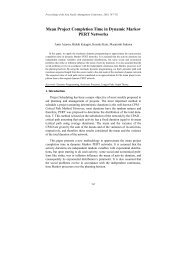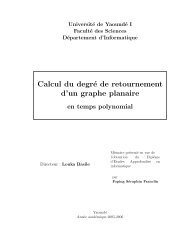Models for Global Constraint Applications - Cork Constraint ...
Models for Global Constraint Applications - Cork Constraint ...
Models for Global Constraint Applications - Cork Constraint ...
Create successful ePaper yourself
Turn your PDF publications into a flip-book with our unique Google optimized e-Paper software.
The first task on machine k is given by variable msucck, and the last task<br />
by mpred k.<br />
Machine dependent duration and machine preference are given extensionally<br />
by functions Di : M ↦→ N and Pi : M ↦→ N. The function Si : I ↦→ N gives the<br />
setup time of task i as a function of the successor variable.<br />
The release date reli is a constant which imposes a hard constraint, since it<br />
is imposed by the availability of raw materials. The due date value duei does<br />
not create a hard constraint, but becomes part of the objective function. The<br />
variable deli is used to indicate the delay of a task.<br />
We first define the domains of the overall schedule ends:<br />
maxm ∈ M (10)<br />
maxe ∈ 0..end (11)<br />
We then have a number of primitive constraints which link the variables of<br />
a task:<br />
∀i∈I : [si, ei, li] ∈ 0..end (12)<br />
∀i∈I : ei = si + di<br />
∀i∈I : li = si + wi<br />
∀i∈I : wi = di + setup i<br />
(13)<br />
(14)<br />
(15)<br />
∀i∈I : element(mi, Di, di) (16)<br />
∀i∈I : element(mi, Pi, pi) (17)<br />
∀i∈I : element(succi, Si,setup i) (18)<br />
∀i∈I : pi ≥ pref min<br />
(19)<br />
Equations 19 are used to impose some global preference rule <strong>for</strong> all tasks. If the<br />
constant pref min is set to a high value, then tasks will be only considered on their<br />
preferred machines, if it is set low, then tasks can move to more machines. This<br />
gives a simple mechanism to switch from normal operations to “fire fighting”<br />
mode, when optimisation criteria are relaxed in order to deliver products on<br />
time.<br />
The links between start, end, release and due dates are given in the next set<br />
of equations.<br />
∀i∈I : si ≥ reli<br />
∀i∈I : del i ≥ ei − duei<br />
∀i∈I : deli ≤ delay max<br />
(20)<br />
(21)<br />
(22)<br />
Equations 22 allows to control the maximal delay allowed on any task. In<br />
particular, it allows to set total delay to zero, <strong>for</strong>cing a solution which delivers<br />
all products on time.<br />
3.2.2 <strong>Global</strong> <strong>Constraint</strong>s<br />
We now introduce the main constraint which deals with the machine assignment,<br />
and which ensures that tasks are not overlapping on machines. This again uses<br />
the diffn [13] constraint already presented in section 2.2.3.<br />
diffn({〈si, mi, wi, 1〉|i ∈ I}) (23)<br />
15









